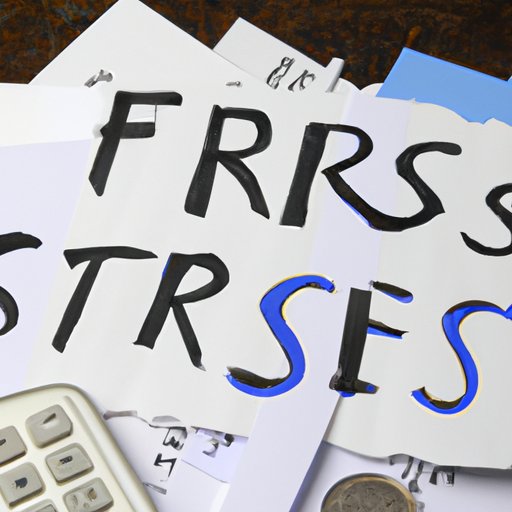Introduction
Financial hardship is a difficult reality for many Americans. It can arise from job loss, medical expenses, divorce or separation, or education costs. This article will explore what financial hardship is, the different types of financial hardship, how to qualify for assistance, the benefits and challenges of assistance, strategies for achieving financial stability during a financial hardship, navigating the legal system during a financial hardship, and managing financial stress during a financial hardship.
Exploring the Different Types of Financial Hardship
Job loss is one of the most common causes of financial hardship. According to a survey conducted by the Federal Reserve Board in 2018, nearly one-third of adults in the United States reported experiencing job loss in their household during the previous year. Job loss can be sudden and unexpected, leaving individuals without income and with mounting bills.
Medical expenses can also lead to financial hardships. A 2016 survey by the Kaiser Family Foundation found that one-quarter of working-age adults have difficulty paying medical bills or are paying off medical debt over time. The cost of medical care has risen significantly in recent years, making it increasingly difficult for households to keep up with payments.
Divorce or separation can also put households into financial hardship. According to a 2019 study by the National Center for Family & Marriage Research, the rate of divorce among married couples aged 50 and over doubled between 1990 and 2015. This often leaves one partner with less income to cover the same number of bills.
Lastly, education costs can lead to financial hardship. According to the College Board, the average cost of tuition and fees at a four-year public college was $10,440 for the 2017-2018 academic year. This can be a significant financial burden for families that are already struggling to make ends meet.

Understanding How to Qualify for Financial Hardship Assistance
When facing financial hardship, individuals may be able to access assistance through various government programs, charities, or private organizations. Each program has its own eligibility requirements, so it is important to do research to find out which programs are available and what the qualifications are.
In general, most programs require documentation to prove that an individual or family is experiencing financial hardship. This may include income verification, proof of assets, proof of debt, and other documents such as bank statements or tax returns.
Examining the Benefits and Challenges of Financial Hardship Assistance
Financial hardship assistance can provide much needed relief for individuals and families facing difficult times. Assistance may come in the form of grants, loans, or other forms of aid. It can help cover basic living expenses, such as rent, utilities, and food, as well as medical bills or other debts.
However, there are also some challenges associated with financial hardship assistance. Some programs may have strict eligibility requirements, and even if an individual is eligible, they may not receive enough aid to cover all of their expenses. Additionally, some programs may require repayment of the funds in the future, which can add to the financial burden.

Achieving Financial Stability During a Financial Hardship
Even with assistance, it is important to take steps to achieve financial stability during a financial hardship. Budgeting is key to understanding where money is going and making adjustments where necessary. Creating a budget and tracking expenses can help individuals identify areas where they can cut back and save money.
Saving money is also important during a financial hardship. Even small amounts can add up over time and provide a cushion in case of emergency. Setting aside money in a savings account can help individuals prepare for unexpected expenses or provide funds for larger purchases, such as a car or home repairs.
Finally, debt repayment should be a priority during a financial hardship. Prioritizing debt repayment can help individuals get back on track financially and avoid further financial difficulties in the future.
Navigating the Legal System During a Financial Hardship
In some cases, individuals may need to navigate the legal system during a financial hardship. Bankruptcy is an option for those who are unable to repay their debts. It can provide relief from certain debts and allow individuals to start fresh financially.
Foreclosure is another option for individuals who are unable to keep up with mortgage payments. It allows homeowners to avoid repossession of their property and may provide them with some financial relief.
Debt settlement is another option for those facing financial hardship. Through debt settlement, individuals can negotiate with creditors to reduce the amount of debt owed, which can help them get out of debt faster.

Addressing Financial Stress During a Financial Hardship
Financial stress can be a major challenge during a financial hardship. It is important to take steps to manage financial stress and keep it from becoming overwhelming. Stress management techniques such as meditation, yoga, and exercise can help individuals cope with financial stress.
It is also important to seek professional help when necessary. Talking to a financial advisor or counselor can provide valuable insights and guidance to help individuals manage their finances during a financial hardship.
Conclusion
Financial hardship can be a difficult and stressful experience. However, with the right information and support, individuals can take steps to manage their finances and get back on track. By understanding the different types of financial hardship, how to qualify for assistance, the benefits and challenges of assistance, strategies for achieving financial stability, navigating the legal system, and addressing financial stress, individuals can find the help and resources they need to weather the storm.
(Note: Is this article not meeting your expectations? Do you have knowledge or insights to share? Unlock new opportunities and expand your reach by joining our authors team. Click Registration to join us and share your expertise with our readers.)
